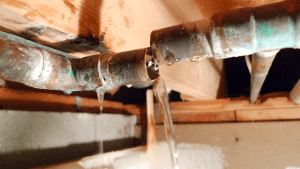Unmasking Concealed Water Line Leaks: Six Smart Detection Methods
Unmasking Concealed Water Line Leaks: Six Smart Detection Methods
Blog Article
The article author is making a few great annotation about Locating water leaks in general in the article below.

Early detection of leaking water lines can mitigate a potential calamity. Some little water leaks may not be noticeable.
1. Check Out the Water Meter
Examining it is a proven means that helps you discover leaks. If it moves, that indicates a fast-moving leak. This implies you may have a sluggish leak that could even be underground.
2. Check Water Consumption
If you detect abrupt adjustments, in spite of your intake being the exact same, it implies that you have leaks in your plumbing system. An abrupt spike in your bill shows a fast-moving leak.
A stable rise every month, also with the same practices, reveals you have a slow-moving leakage that's additionally slowly escalating. Call a plumber to thoroughly inspect your residential or commercial property, particularly if you feel a warm area on your floor with piping underneath.
3. Do a Food Coloring Examination
30% comes from toilets when it comes to water intake. Examination to see if they are running appropriately. Decrease specks of food color in the container as well as wait 10 minutes. If the color somehow infiltrates your bowl during that time without flushing, there's a leakage in between the container and dish.
4. Asses Outside Lines
Do not forget to check your outdoor water lines also. Examination faucets by affixing a yard pipe. Ought to water leak out of the link, you have a loosened rubber gasket. Replace this as well as guarantee all connections are limited. If you have actually got a lawn sprinkler, it will aid get it properly took a look at and maintained yearly. One little leakage can lose lots of water as well as surge your water bill.
5. Evaluate the situation and also evaluate
Property owners need to make it a practice to inspect under the sink counters and also even inside cupboards for any kind of bad odor or mold and mildew growth. These two red flags suggest a leakage so punctual focus is required. Doing routine evaluations, even bi-annually, can conserve you from a significant issue.
Extra significantly, if you know your home is currently old, keep a watchful eye on your heaters, tubes, pipes etc. Look for stainings and also compromising as many pipes as well as home appliances have a life expectancy. They will also naturally deteriorate as a result of damage. If you think dripping water lines in your plumbing system, don't await it to escalate. Call an expert plumber right away so you don't end up with a horrible mess in your house.
Early detection of dripping water lines can alleviate a prospective disaster. Some little water leaks may not be noticeable. Inspecting it is a surefire means that assists you uncover leakages. One tiny leakage can squander loads of water and also spike your water bill.
If you think dripping water lines in your plumbing system, do not wait for it to rise.
WARNING SIGNS OF WATER LEAKAGE BEHIND THE WALL
PERSISTENT MUSTY ODORS
As water slowly drips from a leaky pipe inside the wall, flooring and sheetrock stay damp and develop an odor similar to wet cardboard. It generates a musty smell that can help you find hidden leaks.
MOLD IN UNUSUAL AREAS
Mold usually grows in wet areas like kitchens, baths and laundry rooms. If you spot the stuff on walls or baseboards in other rooms of the house, it’s a good indicator of undetected water leaks.
STAINS THAT GROW
When mold thrives around a leaky pipe, it sometimes takes hold on the inside surface of the affected wall. A growing stain on otherwise clean sheetrock is often your sign of a hidden plumbing problem.
PEELING OR BUBBLING WALLPAPER / PAINT
This clue is easy to miss in rooms that don’t get much use. When you see wallpaper separating along seams or paint bubbling or flaking off the wall, blame sheetrock that stays wet because of an undetected leak.
BUCKLED CEILINGS AND STAINED FLOORS
If ceilings or floors in bathrooms, kitchens or laundry areas develop structural problems, don’t rule out constant damp inside the walls. Wet sheetrock can affect adjacent framing, flooring and ceilings.
https://www.servicemasterbyzaba.com/blog/how-to-detect-water-leakage-in-walls/

As a devoted person who reads about Hacks to detect leaks, I thought sharing that excerpt was essential. Are you aware of anybody else who is truly interested in the topic? Feel free to promote it. Many thanks for going through it.
Excellence on call! Report this page